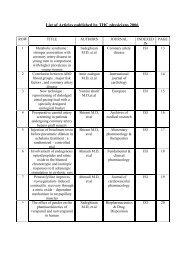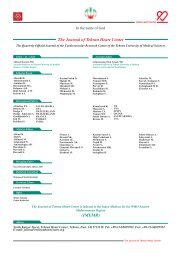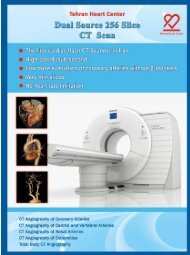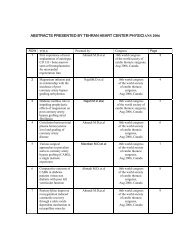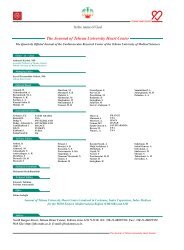THE JOURNAL OF TEHRAN UNIVERSITY HEART CENTER
THE JOURNAL OF TEHRAN UNIVERSITY HEART CENTER
THE JOURNAL OF TEHRAN UNIVERSITY HEART CENTER
You also want an ePaper? Increase the reach of your titles
YUMPU automatically turns print PDFs into web optimized ePapers that Google loves.
The Journal of Tehran University Heart Center<br />
Introduction<br />
Diabetes mellitus (DM) increases the risk of heart failure<br />
development even in the absence of coronary artery disease,<br />
hypertension, or other comorbidities 1, 2 and could result in<br />
a two to fourfold greater mortality in heart failure patients.<br />
Indeed, DM is capable of impairing the myocardial function:<br />
this is initially a clinically silent condition; nevertheless, if<br />
left unrecognized and insufficiently managed, it could beget<br />
overt diabetic cardiomyopathy.<br />
The right ventricular (RV) function plays a significant<br />
role in the overall myocardial contractility. 3 Nevertheless,<br />
most of the previous studies regarding diabetes-induced<br />
changes in myocardial dysfunction were dedicated to the left<br />
ventricle (LV) at the cost of ignoring the role of the right<br />
heart chambers. The existing literature of course does contain<br />
a limited number of studies on the RV cardiomyopathies of<br />
patients with DM type I; however, to our knowledge, there<br />
is only one recent study probing into DM type II drawing up<br />
on three-dimensional strain and strain rate.<br />
The objectives of the present study were to evaluate the<br />
RV systolic and diastolic functions using conventional<br />
echocardiography, tissue Doppler imaging (TDI), and<br />
deformation indices (strain and strain rate) in patients with<br />
DM type II and without coronary artery disease or LV<br />
dysfunction.<br />
Methods<br />
The study group was comprised of 22 diabetic patients (9<br />
men and 13 women) aged 55.6 ± 6.0 years. These patients<br />
either referred to the DM Clinic of Rajaei Cardiovascular,<br />
Medical and Research Center or were amongst the hospital<br />
stuff. The control group consisted of 22 healthy individuals<br />
(9 men and 13 women). All the diabetic patients enrolled<br />
in this study were asymptomatic, without any clinical<br />
evidence of either systolic or diastolic heart failure. The<br />
control subjects were considered to have a low probability<br />
of coronary disease or heart failure based on clinical data.<br />
Coronary artery disease was excluded if there was a<br />
negative Dobutamine stress echocardiographic examination<br />
or a negative treadmill exercise electrocardiographic test.<br />
In a few cases, coronary artery disease was excluded on the<br />
evidence of equivocal non-invasive stress tests and normal<br />
coronary angiograms. The other exclusion criteria included<br />
valvular or congenital heart disease, left ventricular ejection<br />
fraction (LVEF) less than 50%, rhythms other than normal<br />
sinus rhythm, documented pulmonary diseases or pulmonary<br />
hypertension, and tricuspid regurgitation more than a mild<br />
degree.<br />
All the diabetic patients were on a diet and treatment with<br />
oral hypoglycemic drugs. Plasma glucose and HbA1c were<br />
observed periodically and controlled by the endocrinologist<br />
Mozhgan Parsaee et al.<br />
in the aforementioned clinic. None of the patients had such<br />
diabetic complications as progressive and complex diabetic<br />
retinopathy, neuropathy, and nephropathy.<br />
The study participants in the two groups underwent<br />
echocardiographic examinations (Vivid 7, GE Vingmed).<br />
The variables measured are presented as follows:<br />
1. The RV dimension and tricuspid annular plane systolic<br />
excursion (TAPSE) were measured from the apical fourchamber<br />
view.<br />
2. The RV Doppler parameters of the diastolic function<br />
(peak early [A] and peak late diastolic flow velocity [E],<br />
together with their ratio [E/A] and deceleration time [DT])<br />
were recorded. The trans-tricuspid flow was measured in the<br />
apical four-chamber view using pulsed Doppler, with the<br />
sample volume positioned at the tips of the tricuspid leaflets.<br />
The measurements were averaged from three end-expiratory<br />
cycles.<br />
3. TDI was conducted to assess the RV longitudinal<br />
myocardial function in the apical four-chamber view. Color<br />
TDI was used in addition to two-dimensional images,<br />
with adjustment of the depth and sector angle to obtain an<br />
acceptable frame rate. The TDI variables of peak systolic<br />
velocity (Sm), peak early diastolic velocity (Em), peak late<br />
diastolic velocity (Am), myocardial performance index<br />
(MPI), and acceleration time of the isovolumetric contraction<br />
time (IVCT) were analyzed online.<br />
4. The deformation indices were measured by adjusting the<br />
imaging angle to achieve a parallel alignment of the beam<br />
with the myocardial segment of interest. The images were<br />
stored on a remote archive of the echocardiography machine<br />
so that they could be analyzed offline. The myocardial<br />
deformation curves were investigated from the basal segment<br />
of the RV free wall, which belongs to the inflow part of the<br />
RV, and also from the apical segment, which belongs to the<br />
trabecular portion of the RV.<br />
5. The strain rate and stain were measured based on the<br />
standard deformation measurement, and the peak of the R<br />
on the electrocardiography (ECG) was utilized to define<br />
end diastole. End systole was determined using the pulsed<br />
Doppler velocity profile of the left ventricular outflow tract<br />
(LVOT) as the aortic valve closure, and the RV end systole<br />
was determined using the pulsed wave profile of the right<br />
ventricular outflow tract (RVOT) at end expiration. The<br />
analysis of the myocardial strain and strain rate data included<br />
the assessment of the systolic strain (є), peak systolic strain<br />
rate (SRs), and peak early diastolic strain rate (SRe).<br />
The data are expressed as Mean ± SD and percentages. The<br />
Student unpaired t-test was used to evaluate the differences<br />
between the groups, and the chi-square test was employed to<br />
compare the categorical variables. The Pearson correlation<br />
coefficients were utilized to pair the continuous variables.<br />
A two-tailed p value < 0.05 was considered significant. For<br />
the statistical analyses, the statistical software SPSS version<br />
17.0 for Windows (SPSS Inc., Chicago, IL) was used.<br />
178



